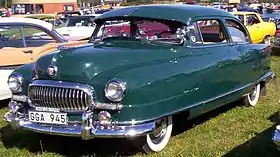| Nash Statesman | |
|---|---|
 1951 Nash Statesman Two-Door Sedan | |
| Overview | |
| Manufacturer | Nash Motors (1949–1954) American Motors (1954–1956) |
| Production | 1950 to 1956 (model years) |
| Assembly | Nash Factory (Kenosha, WI) Danforth Avenue Plant, Toronto Canada (1955) |
| Chronology | |
| Predecessor | Nash 600 |
The Nash Statesman is a full-sized automobile that was built by Nash Motors for the 1950 through 1956 model years in two generations. The Statesman series was positioned between the top-line Nash Ambassador and above the Nash Rambler.
First generation (1950 and 1951)
| First generation | |
|---|---|
.jpg.webp) 1951 Nash Statesman Super Four-Door Sedan | |
| Overview | |
| Manufacturer | Nash Motors |
| Production | 1950 to 1951 (model years) |
| Body and chassis | |
| Body style | 2-door sedan 4-door sedan 2-door coupe |
| Powertrain | |
| Engine | 184 cu in (3.0 L) I6 |
| Dimensions | |
| Wheelbase | 112.0 in (2,845 mm) |
Nash developed its post–World War II automobiles using an advanced unit-body construction with fastback aerodynamic styling under the Airflyte name, reflecting a popular styling trend in the 1950s. The cars were available as a two- or four-door sedan. A distinguishing feature of all Nashes are the "skirted" fenders. Although the turning circle could be compromised, the front track is narrower by nearly three inches: the front is just under 55 inches (1,397 millimeters) while the rear track is 60.5 in (1,537 mm). The base Nash 600 was renamed Nash Statesman for the 1950 model year.[1]
The wheelbase of the Statesman was 9.0 in (229 mm) shorter than the companion Ambassador line. This was achieved by using a shorter front "clip" (the portion of a car from the cowl forward) than was installed on the Ambassador. Statesman and Ambassador hoods along with front fenders are not interchangeable. From the cowl rearward, the two series' dimensions were identical. Two-door models included Nash's exclusive "Airliner Reclining" front seat, which was optional on the four-door sedans. These seats could be converted to form a bed.
Statesman engine designs were based on the L-head Nash Light Six engine that was designed in the 1920s and continued into the 1940s in the Nash LaFayette and Nash 600. It is characterized by the lack of intake and exhaust manifolds. The Statesman models were comparatively lighter resulting in fuel efficiency as reported by owners and testers.
Nash Statesman models were offered in three trims, the top-line Statesman Custom and the entry-level Statesman Super as well as a base fleet-only model for commercial and institutional use.
The Statesman models, along with the Ambassador line, were the volume and profit leaders for Nash.[2]
.JPG.webp) 1950 Nash Statesman Super 4-Door Sedan
1950 Nash Statesman Super 4-Door Sedan.jpg.webp) 1950 Nash Statesman Super 2-door
1950 Nash Statesman Super 2-door
Second generation (1952 through 1956)
| Second generation | |
|---|---|
 1954 Nash Statesman Custom 4-Door Sedan | |
| Overview | |
| Manufacturer | Nash Motors (1952–1954) American Motors Corporation (1954–1956) |
| Production | 1952 to 1956 (model years) |
| Body and chassis | |
| Body style | 2-door sedan 4-door sedan 2-door hardtop coupe |
| Powertrain | |
| Engine | 195.6 cu in (3.2 L) I6 |
| Dimensions | |
| Wheelbase | 114.25 in (2,902 mm) |
A new design was introduced for the 1952 model year featuring a large "envelope-bodied" sedan with enclosed wheels that were characteristic for Nash.[3] The all-new notchback Statesman design coincided with Nash's 50th anniversary and included styling by Pininfarina, the Italian designer.[4]
The 1954 models included the outside mounted "continental" spare tire increasing trunk space and making emergency tire changes easier.[5]
The 1956 models received larger and slanted front parking lights, as well as larger tail lamps.[6]
The final Nash Statesman models were built during August 1956. Starting in 1957 all full-size Nash models were Ambassadors.
 1954 Nash Statesman Custom 4-Door Sedan
1954 Nash Statesman Custom 4-Door Sedan 1956 Nash Statesman Super
1956 Nash Statesman Super
Notes
- ↑ John Gunnell, Standard Catalog of American Cars 1946–1975, Revised 4th Edition, page 554
- ↑ "1952-1954 Nash Ambassador and Statesman". How Stuff Works. 13 September 2007. Archived from the original on 24 September 2020. Retrieved 15 April 2022.
- ↑ "1952 Nash Design". How Stuff Works. 13 September 2007. Archived from the original on 27 August 2019. Retrieved 15 April 2022.
- ↑ Flory, J. Kelly Jr (2008). American Cars, 1946-1959: Every Model, Year by Year. McFarland. pp. 444–447. ISBN 978-0-7864-5230-9. Retrieved 15 April 2022 – via Google Books.
- ↑ Shaw, Wilbur (December 1953). "Nash Hikes Compression, Puts spare Tire Outdoors". Popular Science. 163 (6): 152–155. Retrieved 15 April 2022 – via Google Books.
- ↑ "Nash". Popular Mechanics. 105 (2): 179. February 1956. Retrieved 15 April 2022 – via Google Books.